OP (Optimism): Building a Multi-chain Layer2 Ecosystem
L2 (Layer 2) is undoubtedly one of the most trending narratives in 2023. As L2 technology and ecosystems advanced over recent years, Ethereum has fostered two primary L2 solutions: ZK-Rollups (e.g., zkSync and Starknet) based on zero-knowledge proofs and Optimistic Rollups (e.g., Arbitrum and Optimism) that use fraud-proof.
We introduced Arbitrum in our previous article ARB (Arbitrum): A Layer 2 Leader, and today, we will delve into the background, technology, and current status of another iconic Optimistic Rollup — Optimism.
Optimism’s Background
To resolve the scalability challenge of Ethereum, Ethereum founder Vitalik Buterin and Lightning Network founder Joseph Poon published a paper titled Plasma: Scalable Autonomous Smart Contracts in 2017, proposing the Plasma architecture, which is a non-custodial sidechain solution. Inspired by the new architecture, several Ethereum developers established a non-profit research group called the Plasma Group, which includes Ethereum Foundation researcher Karl Floersch and crypto OG Jinglan Wang, to work on scaling solutions.
While working on this new structure, the researchers noticed that Plasma is subject to some fatal problems. The Plasma Group mentioned that due to the long assets transfer time between L2 and L1, many smart contracts could not run on Plasma. In 2019, the Ethereum community started discussing another scaling solution — Rollup. The Plasma Group combined the Optimistic mode, which was originally designed for Plasma, with Rollup, giving birth to Optimistic Rollup.
Subsequently, Karl and his friend, Uniswap founder Hayden Adams, worked together and released a decentralized trading application called Unipig based on Optimistic Rollup at the Ethereum Devcon. With this demo application, Plasma Group received investment from Paradigm, a top crypto VC, in early 2020 and evolved from a non-profit research organization into a for-profit enterprise named Optimism, focusing on the research of Optimistic Rollup solutions.
The Optimism team maintained close ties with Vitalik, Uniswap, Gitcoin, Consensys, and the Ethereum Foundation back in the Plasma Group period. This is why many core Ethereum developers have been involved in the exploration of Optimistic Rollup. Following the mainnet launch of Optimism, top DeFi applications including Uniswap, Compound, and Synthetix also stated their support.
Optimism’s Tech Solutions
As a fast, stable, and scalable L2 network, Optimism combines the Ethereum Virtual Machine (EVM) with the Optimistic Rollup solution, and its EVM-equivalent architecture allows developers to easily migrate their applications to Optimism.
Optimism's transactions consist of two parts:
1. Cross-chain transactions between L1 and L2;
2. Transactions between two addresses on L2.
As shown in the figure below, through the cross-chain bridge contract, users can easily transfer assets between L1 and L2.
1. The user sends 10 ETH to the cross-chain bridge contract on L1;
2. The contract locks the 10 ETH, and then adds the transaction to the sequencer queue;
3. The sequencer reads the transaction and passes it to the cross-chain bridge contract on L2;
4. The L2 contract deposits the 10 ETH into the user’s L2 address.
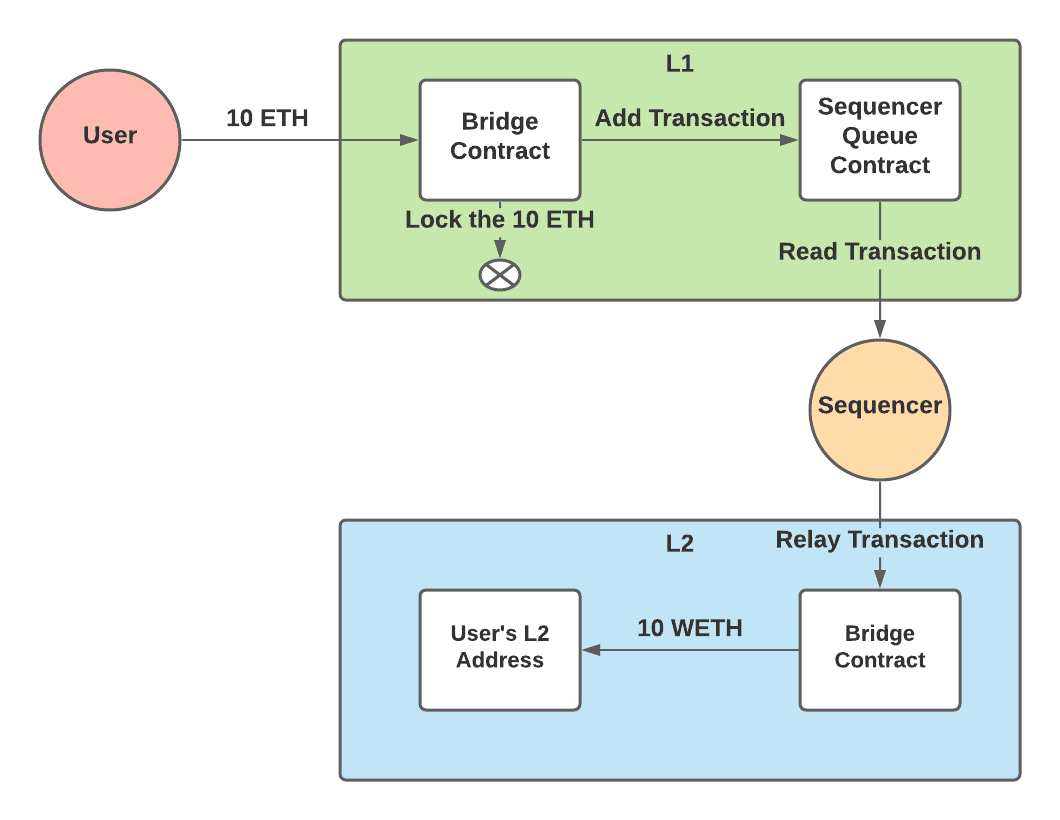
The L1-to-L2 Transaction Process (Source: Optimism Blog)
Transferring assets from L2 to L1 is somewhat different. The cross-chain bridge contract on L2 sends transaction information to the L2ToL1MessagePasser smart contract, which records the data to be sent from L2 to L1. The relay node then reads the data and, after the fraud-proof challenge period (7 days), sends the information to L1, where the data is processed by the cross-chain bridge contract.
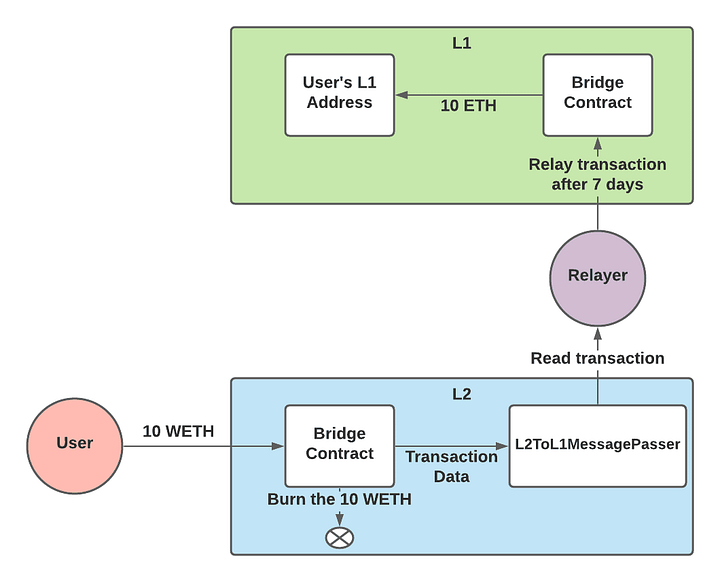
The L2-to-L1 Transaction Process (Source: Optimism Blog)
The following L2 transaction workflow is the main working process of Rollup:
1. The user submits a transaction;
2. The sequencer adds valid transactions to L2;
3. The sequencer packages the data of transactions added to L2, along with the latest state root, and sends and stores it on the L1 smart contract for synchronization;
4. After synchronization, validators include the transactions into L2 replicas.
Fraud proofs represent a critical way for Optimism to keep sequencers honest. If a sequencer publishes a fraudulent state root on L1 (e.g., Alice’s balance decreased by 1 ETH and Bob’s balance increased by 1 ETH, without Alice making any transactions), then anyone could initiate a fraud proof during the challenge period by executing the corresponding L2 transaction on L1.
If the resulting state root of a fraud proof (Alice’s balance remains unchanged) differs from the state root submitted by the sequencer (Alice’s balance changes), the state root would be deemed invalid and recalculated. In this case, the sequencer’s deposit would be taken away, making sure that all L2 transactions submitted to L1 are honest.
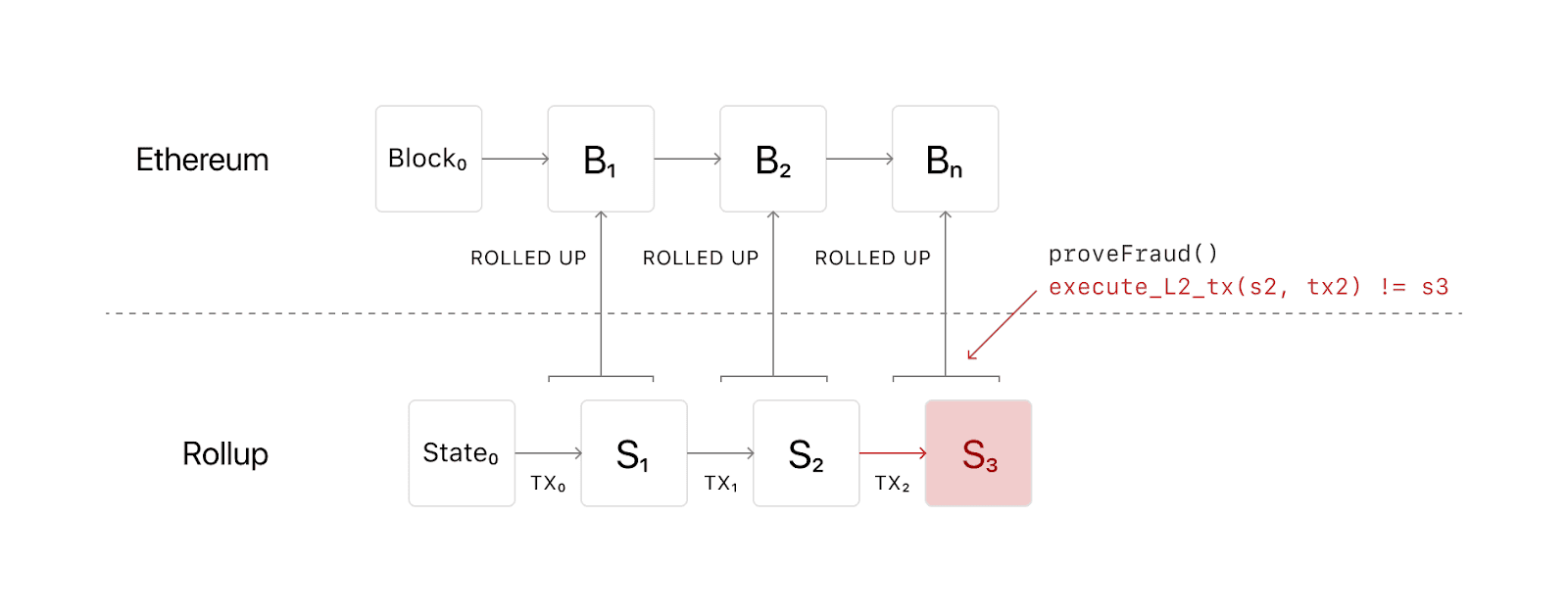
The Fraud Proof Process (Source: The Ethereum Foundation Blog)
Although anyone can initiate a fraud proof, the job is now primarily performed by validators.
The Future of Optimism: Superchain
Right now, Arbitrum dominates the L2 category, while Optimism steadily holds second place, with a market share of 19.69%.
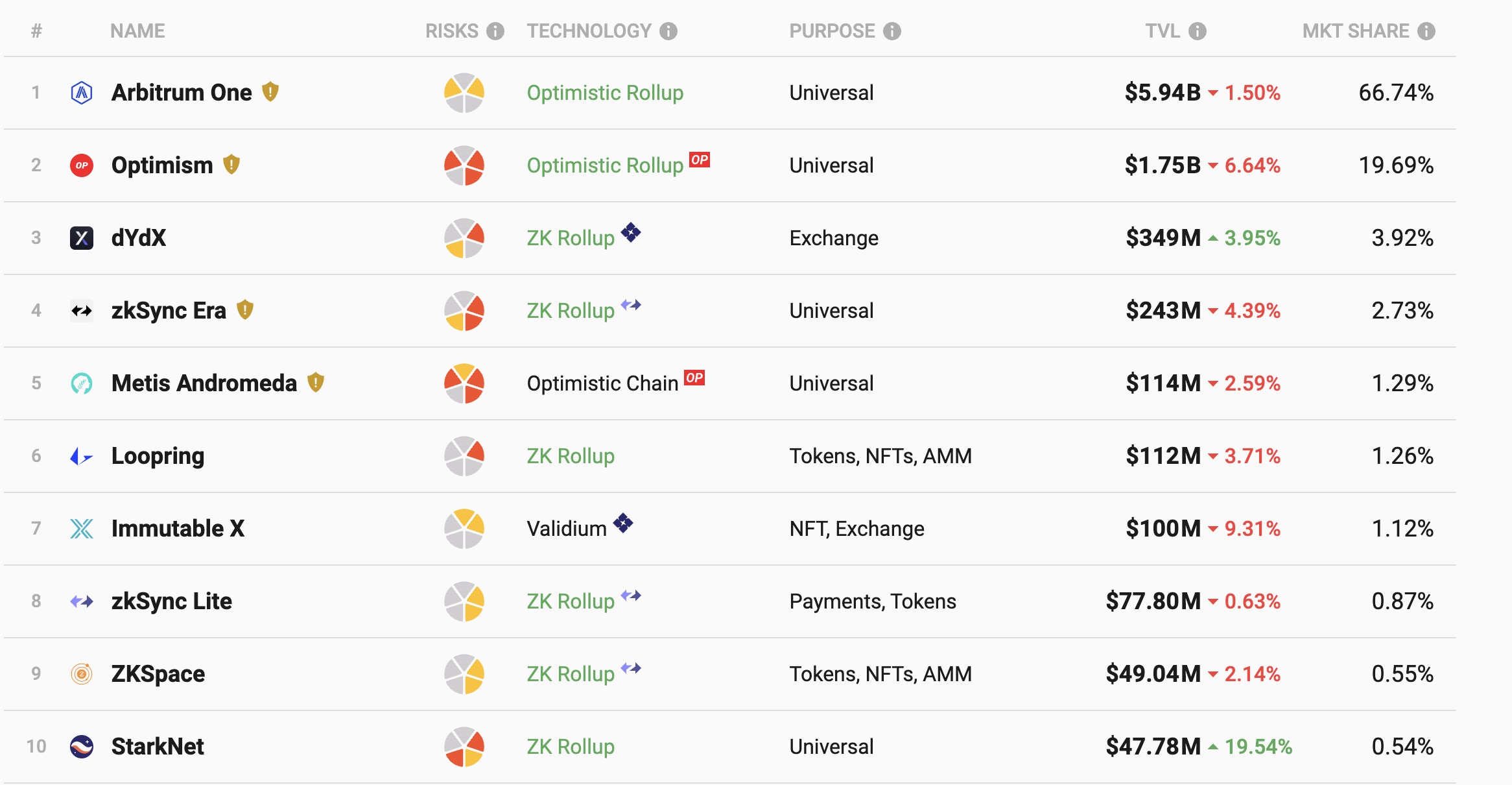
Source: L2BEAT (As of May 10)
Although Optimism is no match to Arbitrum in terms of market share, the network remains optimistic and has blazed a new trail. Last year, Optimism became the first L2 project to issue a native token and proposed an innovative decentralized governance model called Optimism Collective. Soon after, Optimism Collective released a standardized open-source module called OP Stack, which helps developers easily build L2 on Ethereum, just like building L1 with Cosmos.
This February, crypto exchange Coinbase announced a partnership with Optimism and launched BASE, an L2 network based on OP Stack. On the same day, Optimism Collective announced the Superchain project, which aims to bring together multiple isolated L2 chains into an interoperable, composable system, creating a unified chain network.
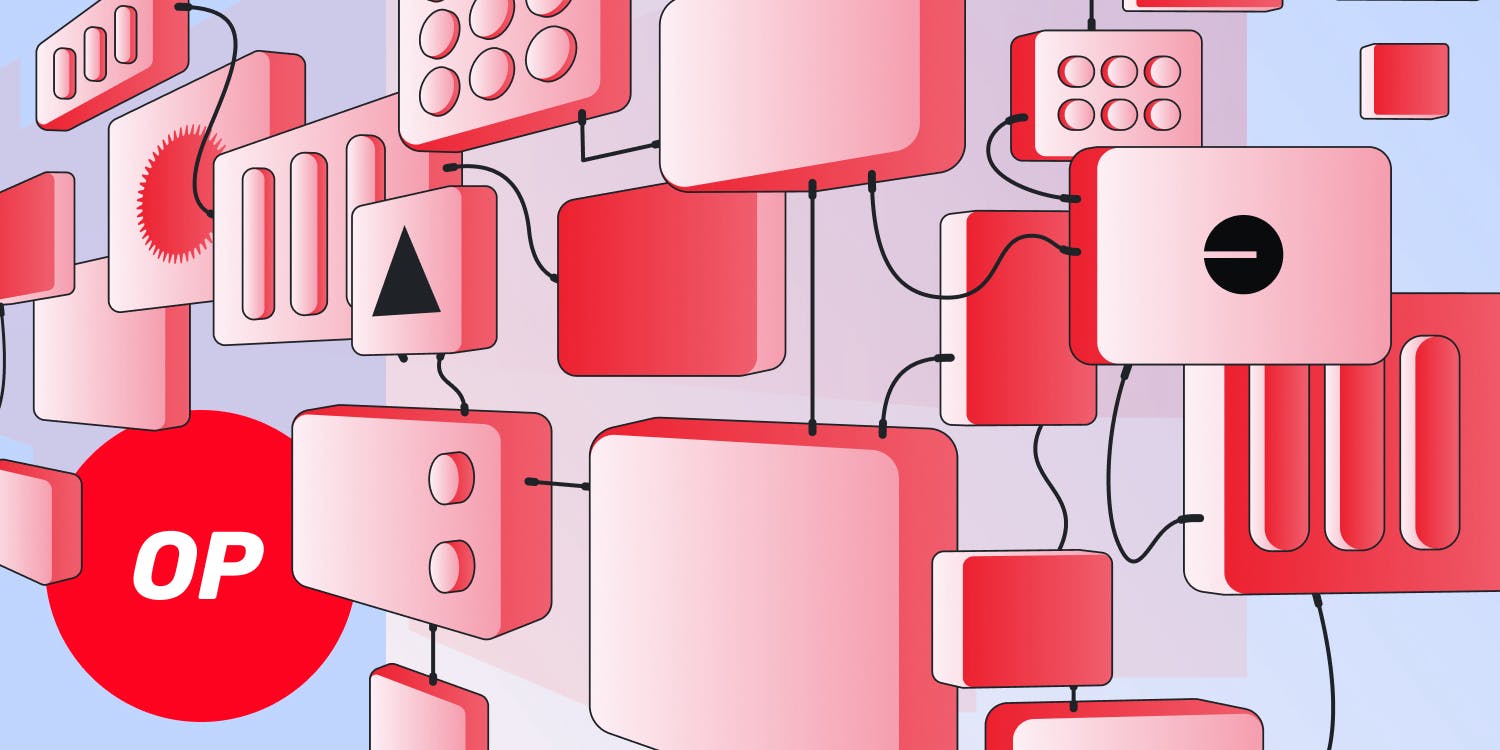
Source: The Optimism Collective
The Superchain now includes Optimism’s mainnet, the BASE network, and other L2s that may join the project in the future. Optimism’s long-term goal is to turn the Superchain into a sprawling network that maximizes interoperability and shares decentralized protocols, thereby building a multi-chain L2 ecosystem.
Users can now manage their OP in CoinEx Wallet. Download the app and try it out: https://wallet.coinex.com/download
[More Information]
Optimism website:https://www.optimism.io/
Market cap ranking:https://coinmarketcap.com/currencies/optimism-ethereum/
Optimism Docs:https://community.optimism.io/








